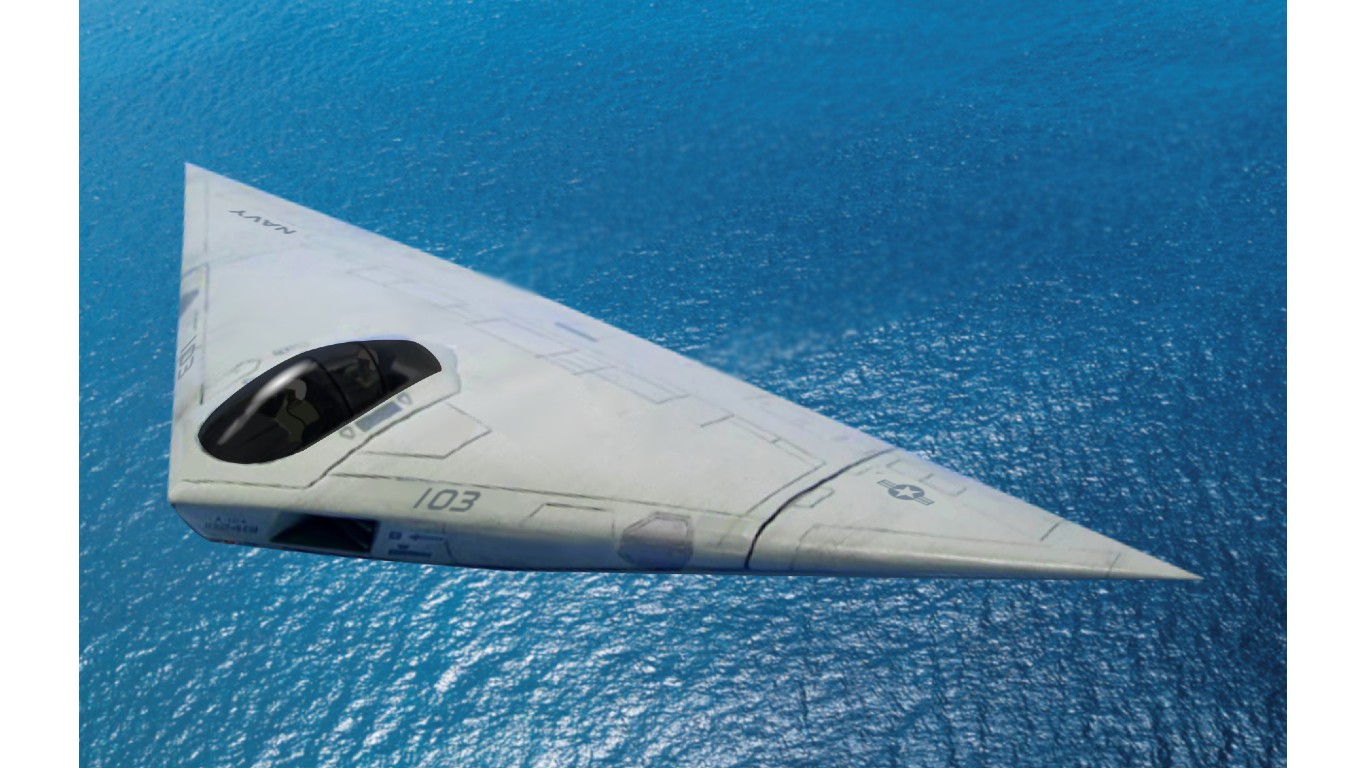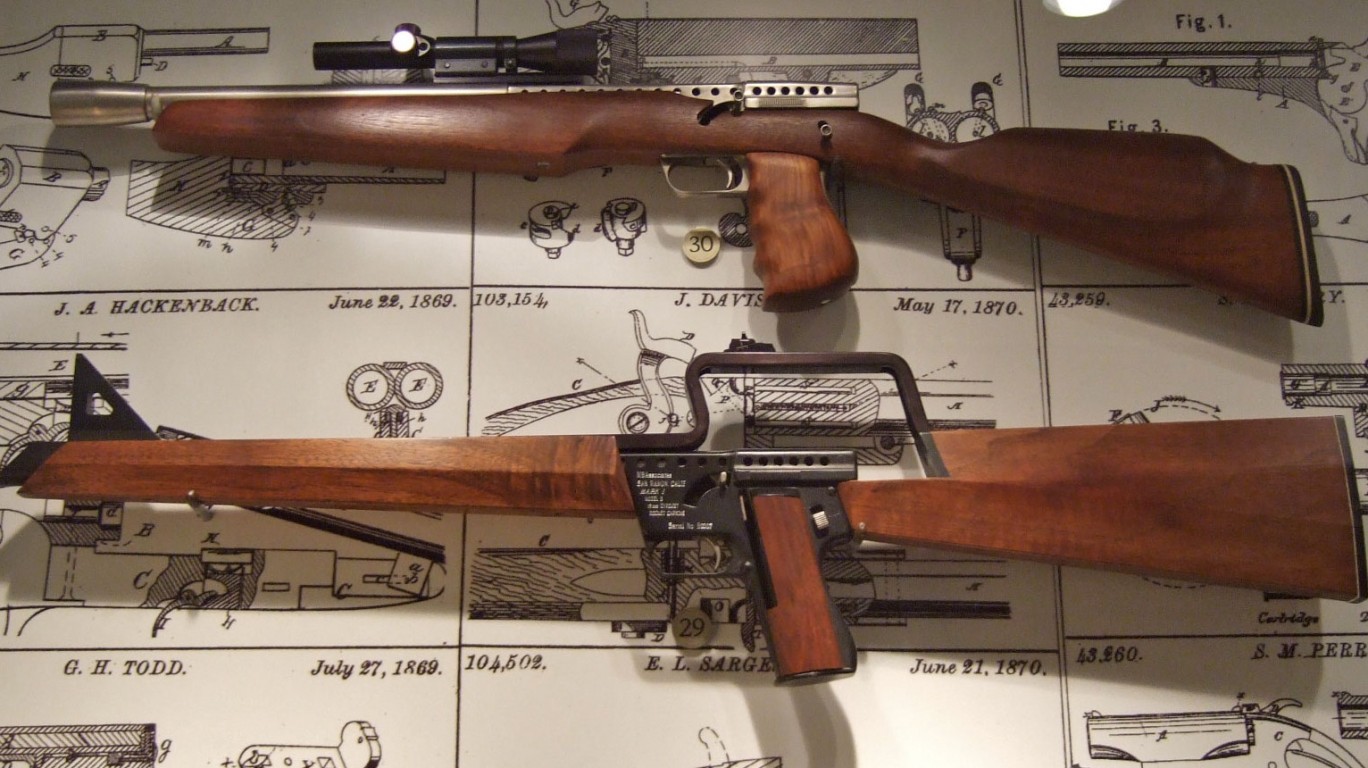
The United States spends more on its military than any other country in the world, with a yearly budget of $801 billion as of 2021.
What are we spending this absurd amount of money on? Thanks to the Freedom of Information Act, which was established in 1967, citizens are able to get a glimpse of at least some of the military projects their tax money has been going towards. (See the other countries spending the most on war.)
The results are not always something for the military to be proud of. Some of its initiatives have been downright strange, and ultimately prove unworkable and get canceled. Using a variety of military-focused and news sources, 24/7 Tempo has compiled a list of the weirdest canceled U.S. military projects. Some of these never made it beyond the drawing board, while others were created but not used in the field.
Click here to see the weirdest canceled military projects
Flying saucers, cyborg spy cats, and even a “gay bomb”…. The American military-industrial complex (to use a phrase coined by President Dwight D. Eisenhower in 1961) has tried it all. They may say that “All’s fair in love and war,” but some of these projects raise serious ethical concerns – particularly those that used animals as weapons and experimented on human test subjects. Along with ethical concerns, there is the issue of price, with some of these projects costing billions of dollars and producing no viable results. (These are the failed weapons the U.S. wasted the most money on.)
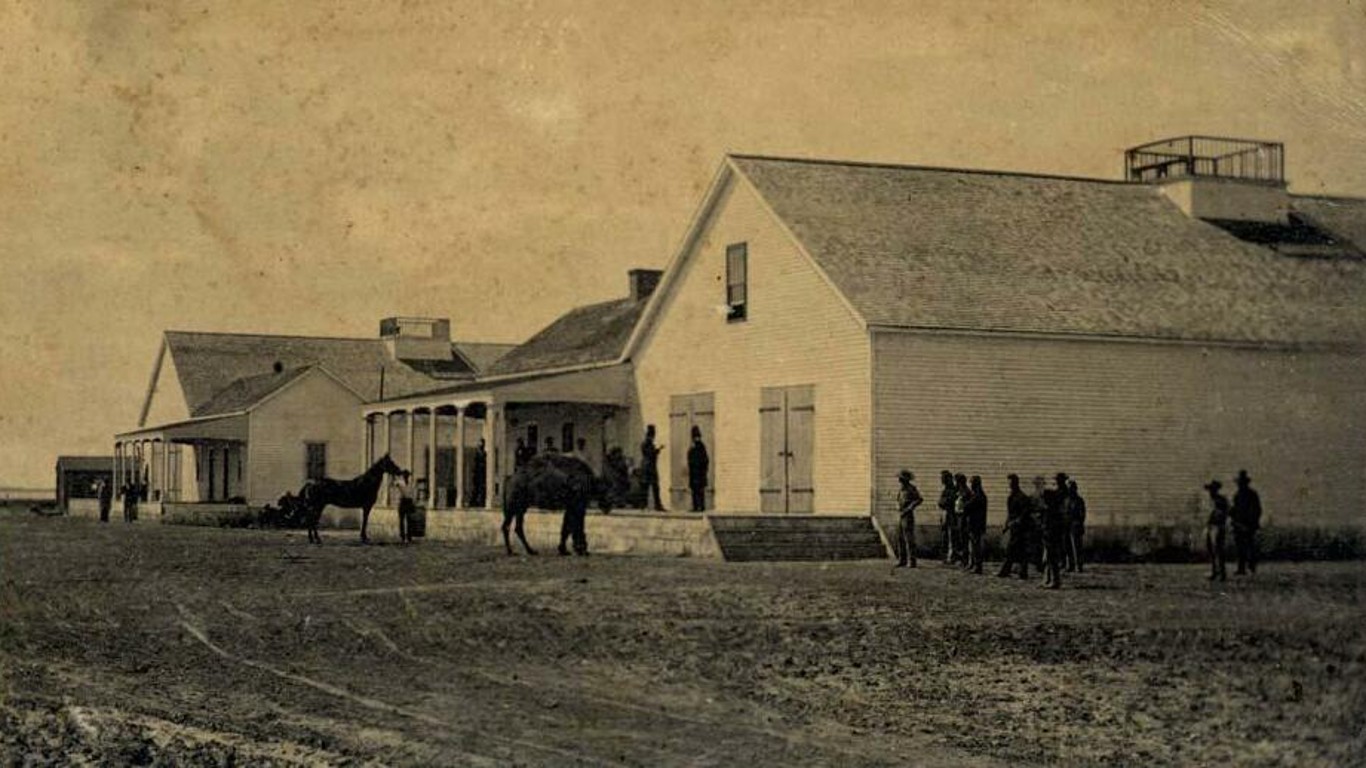
Camel Corps
> Time period: 1855-1861
> Type: Soldiers mounted on camels
> Project goal: Move through harsh terrain
Camels have been used for centuries to cross desert terrains, particularly in Northern Africa and the Middle East. In 1856, Jefferson Davis, the future president of the Confederacy but at the time the U.S. secretary of war, saw them as a viable solution for traversing the country’s Southwest during the Mexican-American War. Congress agreed to try this experiment and funded the purchase of 70 camels, costing a total of $30,000 (over $1 million adjusted for inflation), and the Camel Corps was born.
The Camel Corps was a huge success, with the camels vastly outperforming the mules that were traditionally used for these expeditions. Despite the success of the experiment, the U.S. government did not invest further in the program as it had more pressing concerns with the Civil War breaking out in 1961. The remaining camels were sold off in 1864 for $1,945 (about $18,600 adjusted for inflation). This is one of the many examples of the United States’ use of animals as military technology.
[in-text-ad]
Project Pigeon
> Time period: 1940s
> Type: Pigeons sealed into missiles
> Project goal: Guide missiles on target
Along with camels, pigeons have seen a wide variety of uses throughout history. Primary among them being used to deliver messages, particularly during times of war. But who would have thought they would be used to “deliver” bombs to targets on the battlefield? During WWII, the United States was struggling to find a more reliable way to aim missiles. The man who offered a solution was the famed psychologist B.F. Skinner, who had experience working with pigeons in his studies.
Skinner’s idea, which he dubbed “Project Pigeon,” was (relatively) simple: put the birds in the cockpit of a missile with a screen viewing the ground below them, having trained them to recognize enemy targets and peck the screen when they saw one. When they did so, cables attached to their heads would steer the missile toward the target. The National Research Defense Committee granted $25,000 (around $411,350 adjusted for inflation) for Project Pigeon, but even after a few successful tests, they decided to halt the project. Maybe it was just too weird of an idea to see through.
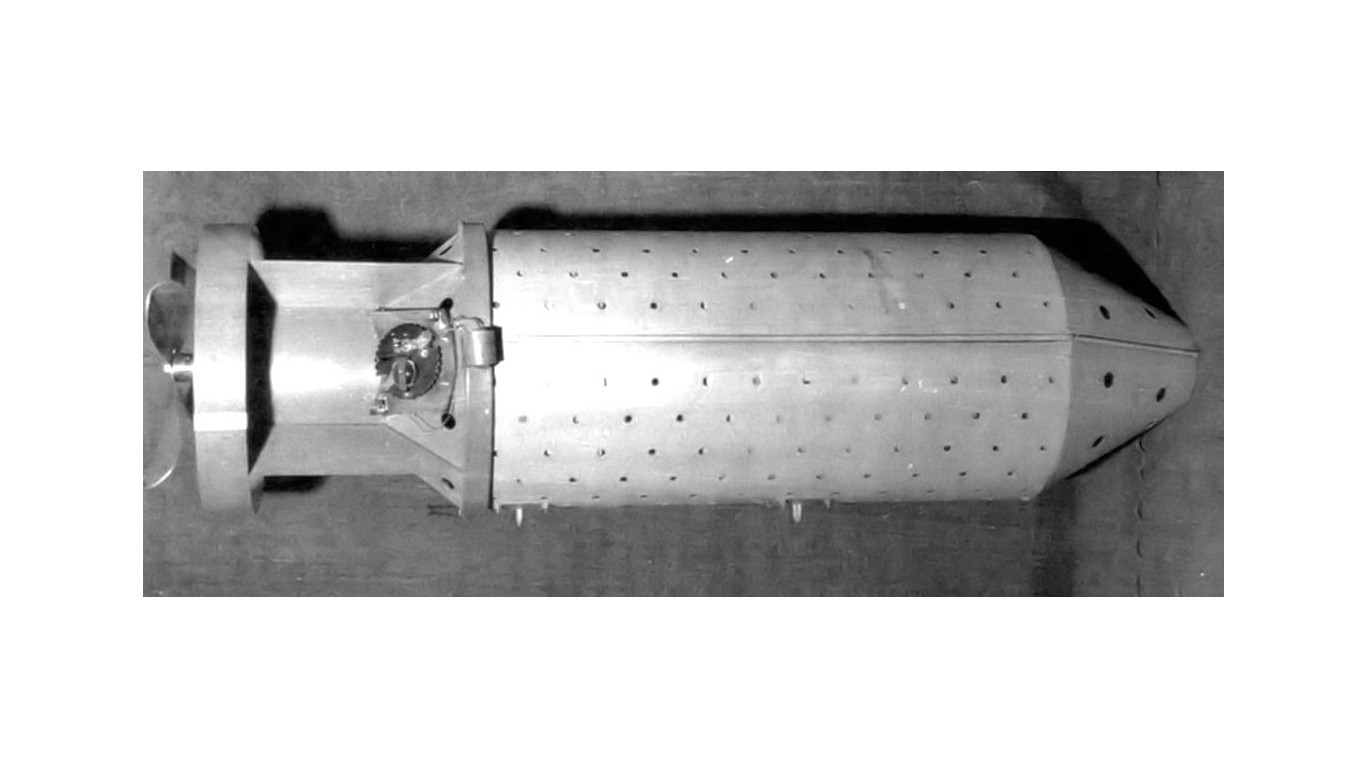
Bat Bomb
> Time period: 1940s
> Type: Bats carrying bombs
> Project goal: Infiltrate incendiary bombs into Japanese cities
In keeping with the theme of weaponizing animals, consider the bat bomb. In 1942 a dental surgeon named Lytle S. Adams came up with a strange plan to turn the tide of the war in Japan. His idea was to drop bats strapped with timed incendiary bombs into every Japanese city, wait for them to nest, and then ignite the charges. As Adams put it “Think of thousands of fires breaking out simultaneously over a circle of forty miles in diameter for every bomb dropped. Japan could have been devastated, yet with small loss of life.”
This plan may sound crazy, but it actually had the stamp of approval from Eleanor Roosevelt. Unfortunately, during initial testing, a handful of weaponized bats escaped, which led to the destruction of a hangar and a general’s car. The project was then handed over to the Marine Corps, who spent $2 million (about $36,340,000 today) on the project, only to abandon it within a year.
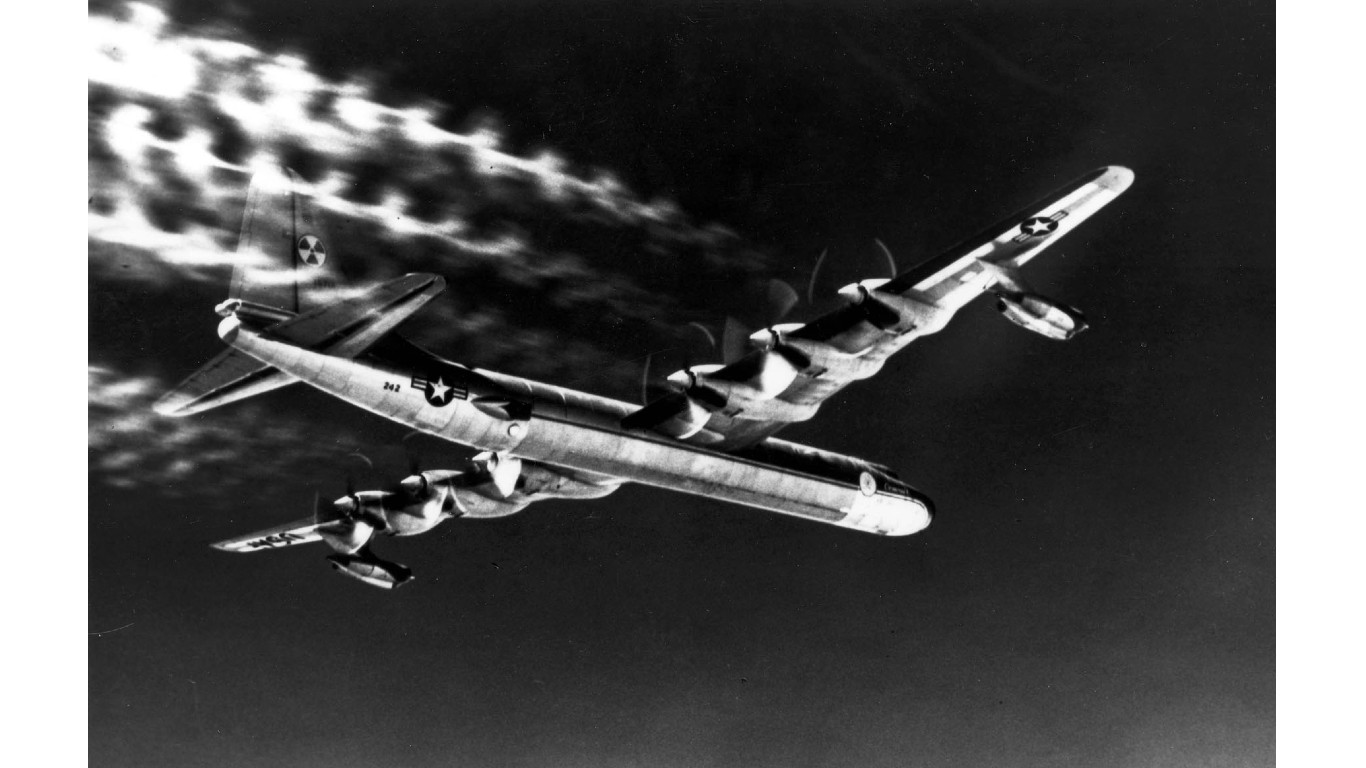
Convair X-6
> Time period: 1946-1961
> Type: Nuclear-powered aircraft
> Project goal: Develop a nuclear-powered jet that could stay airborne for weeks
After the United States dropped the first nuclear bomb in 1945, we began tests on how we could harness nuclear energy for other military projects. One of those projects was the development of a nuclear-powered aircraft dubbed the “Convair X-6,” which fell under the umbrella of a series of projects that ran from 1946 into the Cold War and was eventually scrapped in 1961. The use of nuclear energy would have allowed the plane to stay airborne for weeks at a time, if not longer.
To test the feasibility of this experimental aircraft, Convair B-36 bombers were converted to house nuclear engines. The first of these bombers, called the Nuclear Test Aircraft (NTA), completed 47 test flights between 1955 and 1957, during which the nuclear reactor was active for around 20% of the time. The Convair X-6 was never completed and ended up costing a whopping total of $7 billion (which is about $61 billion adjusted for inflation). This is one of the first of many failed aircraft projects from the Cold War.
[in-text-ad-2]
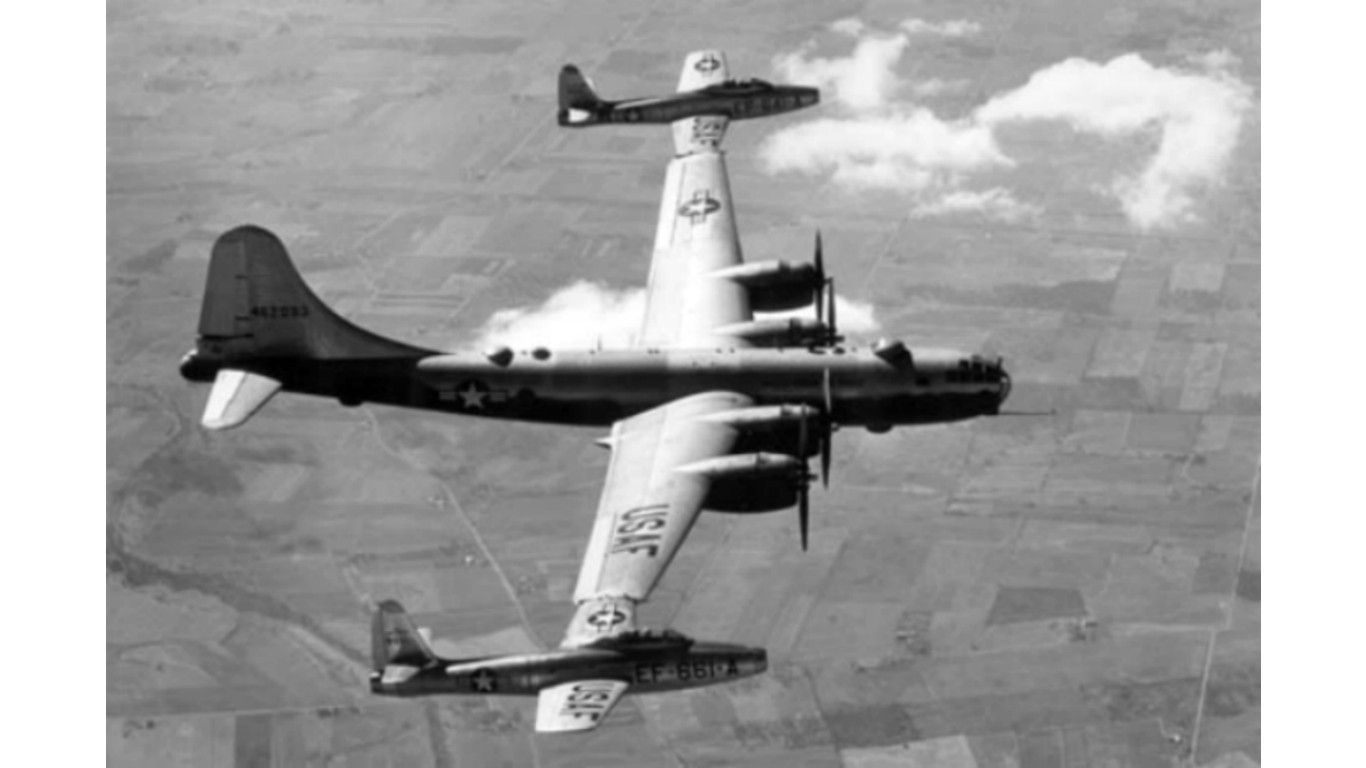
Project Tip-Tow
> Time period: 1950s
> Type: Fighter jet
> Project goal: Increase fuel efficiency
Nuclear-powered aircrafts were not the only idea to increase the amount of time aircrafts could remain in flight. Another idea was to attach fighter jets to each wing of a bomber jet with a series of coupling mechanisms. Joining them together would work symbiotically to increase the fuel efficiency of the fighter jets and provide a convoy for the bomber. This was an idea that was so crazy, it might just have worked.
Initial small-scale tests proved promising, but when they switched to the real planes, a Boeing ETB-29A bomber and two Republic EF-84D Thunderjets, problems arose. The bomber’s wings were very flexible, which led to large amounts of shaking during flight. Sometimes the shaking got so bad that the planes would have to disengage using explosive bolts. Further experiments were done to address the shaking problem, but unfortunately these led to one of the bomber configurations crashing, killing all who were onboard. This accident essentially spelled the end for Project Tip-Tow. In any case, advancements in refueling technology and the invention of more fuel-efficient jets, rendered the whole concept obsolete.

XF-84H Thunderscreech
> Time period: 1950s
> Type: Turboprop aircraft
> Project goal: Take off from carriers without catapult assistance
Another weird experimental aircraft from the Cold War was the XF-84H Thunderscreech. This plane was equipped with a supersonic propeller and a turbine engine. This meant that it had the power to take off from a carrier without an aircraft catapult. However, with the increased acceleration power came increased noise. They didn’t call it the Thunderscreech for nothing; this plane holds the record for being the loudest aircraft ever made. It was so loud that you could hear it from 25 miles away, and if you were close up, it could cause extreme nausea or even blow out your eardrums. The project was eventually canceled in 1956 due to the noise problems as well as failure to meet certain aerodynamic standards.
[in-text-ad]
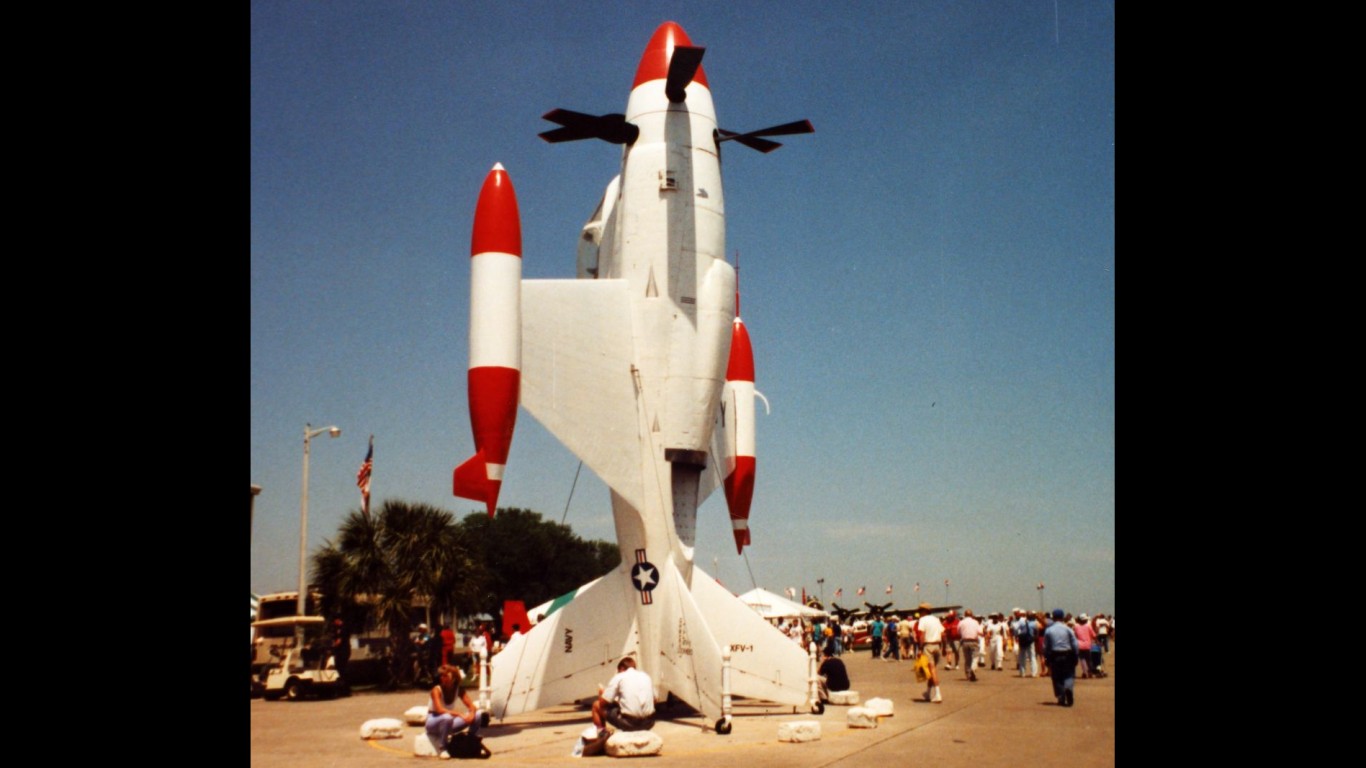
XFV Salmon
> Time period: 1951-1955
> Type: Jet aircraft
> Project goal: Take off and land without a runway
In the early 1950s, the U.S. government wanted fighter planes aboard all of their ships, not just carriers. Due to the limited space on conventional vessels, the aircraft would have to have to be designed to take off vertically. Thus, the XFV Salomon was born. This plane stood straight up into the air with its landing gear being placed on the tail of the plane. It doesn’t sound too crazy in theory until you ask the question, “How do you land this thing?” This issue, coupled with the aircraft’s poor speed, led to the XFV Salomon being canceled in 1955. (Today, new technology has made vertical take-off jets possible; the most prominent example is Lockheed’s F-35.)

Edgewood Arsenal Drug Experiments
> Time period: 1955-1975
> Type: Hallucinogenic drugs
> Project goal: Test drugs that could disrupt enemies’ mental processes
During the Cold War, the United States carried out some experiments that were ethically questionable. Among those were the Edgewood Arsenal Drug Experiments, carried out for a period of 20 years. Over the course of the project, the U.S. military tested a variety of “non-lethal incapacitating agents” on over 5,000 military volunteers, many of whom did not fully understand what they signed up for.
The most controversial of the substances tested was what is known as BZ. The military describes its effects as disrupting “the high integrative functions of memory, problem-solving, attention, and comprehension,” adding that “A relatively high dose produces toxic delirium, destroying the individual’s ability to perform any military task.” BZ also caused delusions and hallucinations similar to those induced by substances like LSD. The project was terminated in 1975 after a congressional hearing. Despite lasting two decades and causing untold suffering amongst its participants, there was little usable data gained from these experiments.
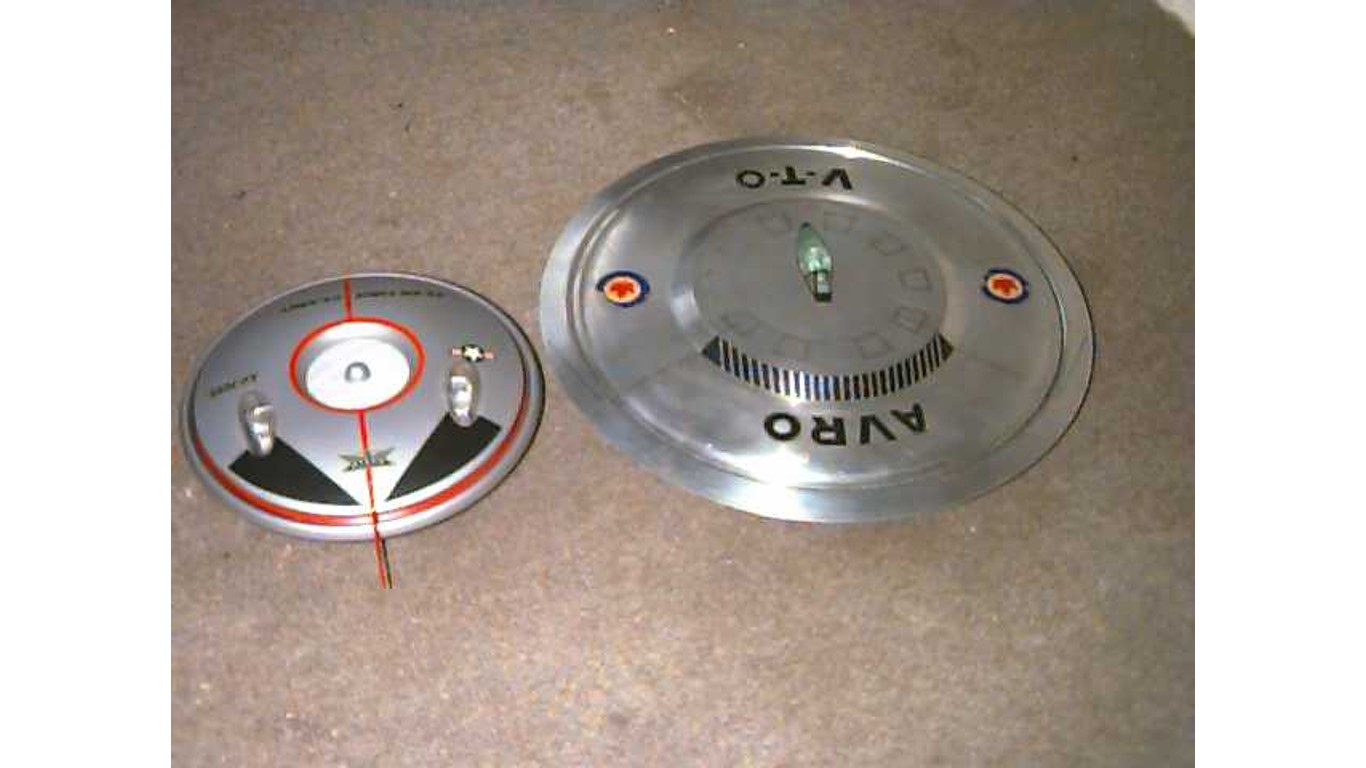
Project 1794 (“Canadian Flying Saucer”)
> Time period: 1956-1961
> Type: Vertical takeoff aircraft
> Project goal: Combat incoming Russian ballistic missiles
Project 1794 was another weird Cold War aircraft. The United States was in search of a vertical take-off vehicle that could function in case airfields were destroyed by the Soviets. Learning from their mistakes from the XVF Salmon, the U.S. sought solutions that would involve more than just positioning an aircraft on its tail. A promising innovation was dreamt up by the Canadian company Avro Aircraft . It took the form of what was essentially a flying saucer, and was promised to have flying saucer capabilities, such as a speed of 2,6000 miles per hour and the ability to hover at a height of 100,000 feet. Unfortunately, Avro greatly over-promised: It turned out that the “saucer” reached a top speed of only 35 miles per hour and could hover no more than three feet off the ground. In addition, the price tag was $3,168,000 ($26.6 million adjusted for inflation) per aircraft – so not surprisingly Project 1794 was canceled.
[in-text-ad-2]
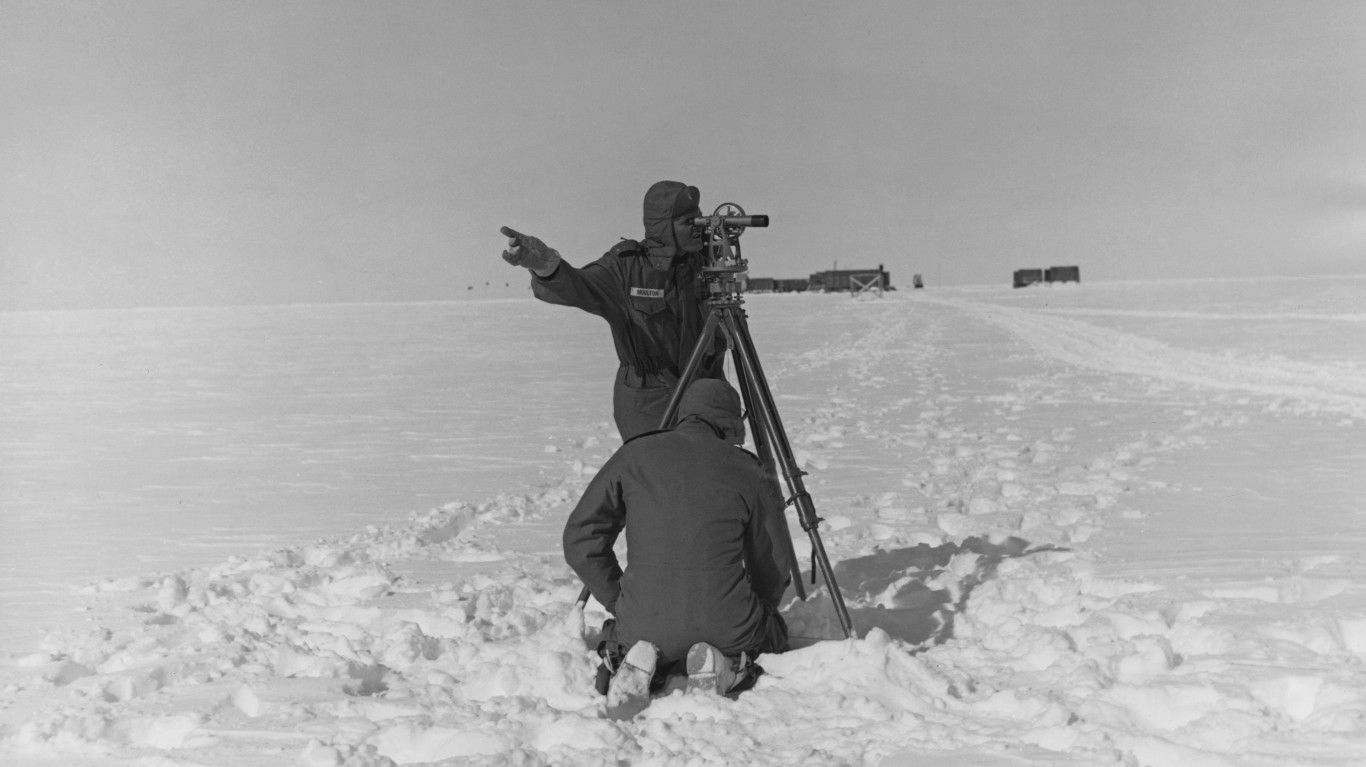
Operation Iceworm
> Time period: 1958-1966
> Type: Ice base
> Project goal: Store ballistic missiles under ice caps to evade Soviet detection
During the Cold War, the U.S. devised a plan to hide a stockpile of hundreds of ballistic missiles in a secret network of tunnels beneath Greenland’s ice cap. The idea was tested at an American research base in Greenland called Camp Century, an underground nuclear-powered mini-city that was home to over 100 soldiers. The experiment was initially a success, but ultimately environmental factors (ice and snow compromised the structural integrity of the base), political disputes, and problems with the nuclear reactor led to cancellation of the project in 1996, and Camp Century was abandoned the following year. “Operation Iceworm” was estimated to have cost around $2.37 billion (about $25.8 billion adjusted for inflation) – and on the way out, the U.S. didn’t bother to clean up its toxic waste, which now could spill into the ocean due to rising sea levels.

Manned Orbiting Laboratory
> Time period: 1960s
> Type: Orbiting laboratory
> Project goal: Spy on the Soviet Union from space
As the Cold War heated up and the U.S. was attempting to one-up the Soviet Union in the space race, the Department of Defense conceived a plan to run surveillance on the Soviet Union via a space station referred to as the Manned Orbiting Laboratory. It would be staffed by a two-man crew, taking photos and recording data for periods of 30 days at a time. The project made it pretty far off the drawing board, all the way to the hardware phase, before being canned by Richard Nixon in 1969. The program had become outdated as other surveillance technology advanced rapidly, and the government shifted its budgeting priorities to the Vietnam War. With a price tag of $1.56 billion (over $12.1 billion adjusted for inflation), this serves as another expensive Cold War idea that never made it off the ground.
[in-text-ad]
Gyrojet
> Time period: 1960s
> Type: Rifle-fired rockets
> Project goal: Improve speed and range for the projectile
The Gyrojet was an experimental rifle firing rocket-propelled bullets, intended for use in the Vietnam War. The idea was that since the weapon would not have to be reinforced to withstand the blast of the exploding gunpowder from traditional bullets, it would be lighter – and recoil would also be reduced. More important, because the bullet was rocket-powered, it would pick up speed as it traveled, increasing its range and lethality. The downside was that the barrel had to be straight rather than grooved as in a conventional rifle, making the bullets less accurate. As with the Manned Orbiting Laboratory, it was judged that the Gyrojet’s potential benefits didn’t justify the cost of perfecting it, especially when funding the Vietnam War took priority. Various Gyrojet models were manufactured and are still collected to this day, but you’d have to pay a pretty penny for the rare experience of firing one, as the ammunition can cost over $100 a round.
Acoustic Kitty
> Time period: 1960s
> Type: Cats
> Project goal: Use non-humans to commit espionage
It is no secret that the CIA has tried some weird espionage tactics, particularly during the Cold War, but one of the weirdest was the project dubbed “Acoustic Kitty.” The goal was to create a sort of cat cyborg, a live animal surgically implanted with a tiny microphone and transmitter. The idea was that cats could be placed near targets to listen in on their conversations. This cruel project was not very well thought-out, as cats are almost impossible to train. The first test went about as well as you’d imagine: Within minutes of the cat being dropped in on its mission, it ran off into the street and was hit by a taxi. The project did not last much longer and was eventually canceled in 1967, not before racking up a total cost of $20 million (over $177 million adjusted for inflation).
B-70 Valkyrie
> Time period: 1960s
> Type: High-altitude bomber
> Project goal: Carry nuclear weapons very fast and at high altitude
The B-70 Valkyrie was another experimental aircraft dreamt up during the Cold War. It was originally designed in the late 1950s as a futuristic nuclear-armed super-weapon capable of flying at three times the speed of sound and cruising over 15 miles above the ground. Its lightning-fast speed made it near impossible for enemy jets to keep up, let alone shoot it down. However, the Soviet Union made advancements to its high-altitude surface-to-air missile technology which negated the plane’s benefits.
The U.S. then attempted to use the Valkyrie at lower altitudes so as to not waste the technology, but it did not perform as well as the much cheaper and more fuel-efficient B-52 bomber already designed for that role. The final blow to the program was the development of intercontinental ballistic missiles, which were more cost-efficient than the Valkyrie, which cost $24 million (close to $238 million adjusted for inflation) per plane. Being the fastest aircraft ever wasn’t enough to save it, and President Kennedy shut down the program in 1961.
[in-text-ad-2]
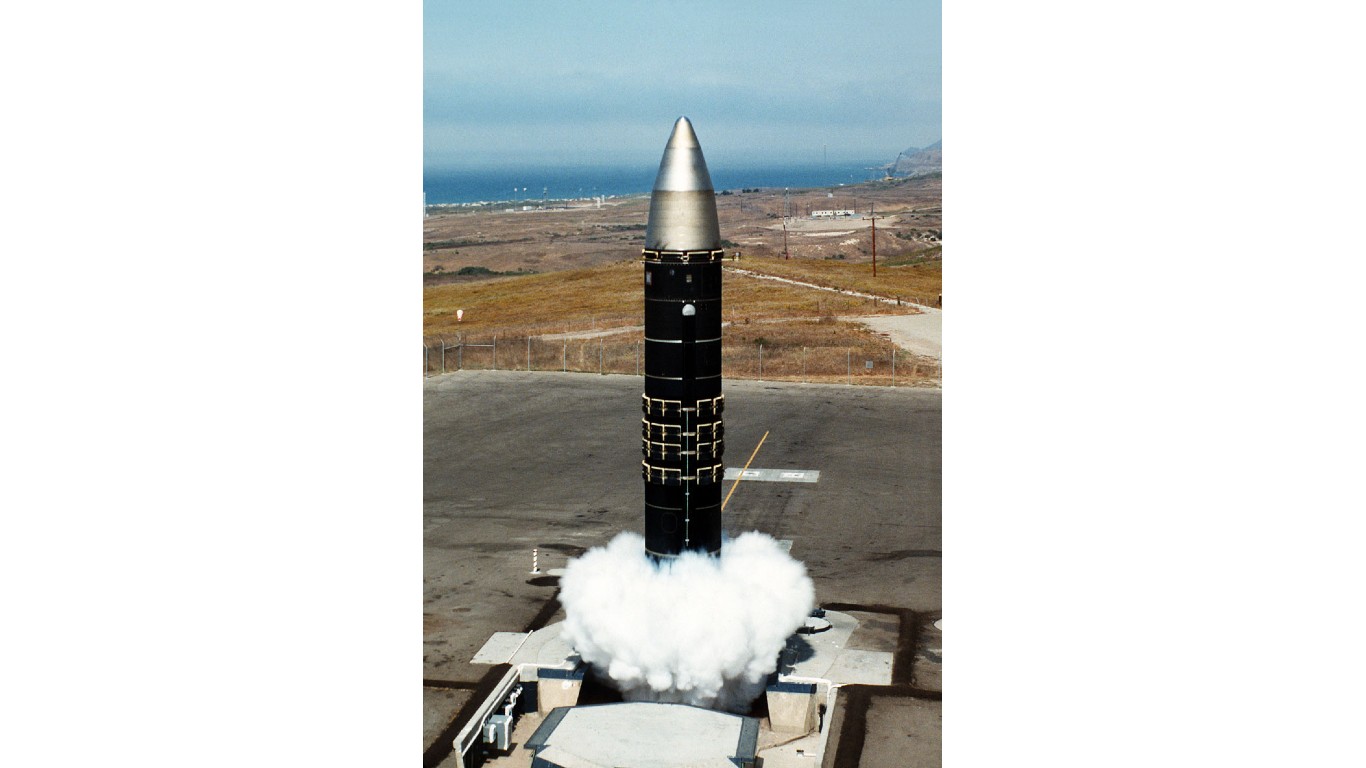
LGM-118 Peacekeeper
> Time period: 1970s
> Type: Nuclear missile
> Project goal: Take out Soviet Union with one blow
In the 1970s the United States came up with a device that had the potential to win an all-out nuclear war in one blow. This came in the form of the LGM-118 Peacekeeper, an intercontinental ballistic missile capable of carrying 10 re-entry vehicles, each armed with a thermonuclear warhead that could cause unfathomable destruction. The program was extremely costly and there were many complications concerned with housing and maintaining the missiles. The first Peacekeeper was deployed in 1986. In 1993, however, the U.S. and the Soviet Union signed the Strategic Arms Reduction Treaty (START II), banning the use of ICBMs with more than one warhead, rendering the Peacekeeper useless. We eventually withdrew them from our arsenal, the program was officially canceled in 2003, and the last missile was deactivated by 2005. Over its three-decade run time, the project cost a total of $25 billion.
Project Stargate
> Time period: 1972-1995
> Type: Paranormal experiments
> Project goal: Use ESP and other paranormal skills to spy
One of the weirdest projects on this list is the CIA’s Project Stargate, which employed psychics to help with espionage during the Cold War. The psychics used a technique called “remote viewing” which supposedly allowed them to see something going on from miles away, like wizards looking into crystal balls. Surprisingly the program actually had some successes, as when psychic Joseph McMoneagle, an army veteran, was able to locate hostages in Iran and also divined that a KGB agent was concealing a shortwave radio inside a calculator. Nonetheless, the program was declared a failure by the Pentagon and officially canceled in 1995.
[in-text-ad]

Strategic Defense Initiative
> Time period: 1980s
> Type: Defensive system
> Project goal: Thwart incoming nuclear missiles
Also known as “Star Wars,” the Strategic Defense Initiative was another strange Cold War project. Introduced in 1984 by Ronald Reagan, it was designed as a defensive grid that would shoot down incoming submarine-launched and intercontinental ballistic missiles. The Strategic Defense Initiative Organization was created to develop the project, and everything from space-based missile systems to lasers was considered. The objective soon proved to be difficult to achieve, as the technology available just wasn’t sufficiently advanced. With the Cold War coming to an end in the 1990s and nuclear stockpiles being reduced, program came to seem redundant – and in any case, it was estimated that the grid would have been able to stop only 16% of Soviet missiles. Officially canceled in 1993, the project ended up costing over $30 billion.

Peacekeeper Rail Garrison
> Time period: 1986-1991
> Type: Railway-transported missile system
> Project goal: Evade Soviet missile attack
The Peacekeeper Rail Garrison was developed in 1986 as a way to shuffle around and launch nuclear weapons in the event that the United States’ regular missile silos were destroyed in a first-strike attack by the Soviet Union. With trains stationed all across the country moving at full speed, it would have been impossible for the Soviet Union to hit all of them. Only one prototype was ever built before the program’s cancellation in 1991 as the Cold War began to wind down.

Lockheed Martin F-35 Lightning II
> Time period: 1990s
> Type: Fighter jet
> Project goal: Develop a futuristic fighter for use by all military branches and NATO
The Lockheed Martin F-35 Lightning II is one of the most expensive failed military projects of all time, with a price tag of over $1.5 Trillion between 1996 and today. The goal was to replace the F-22 Raptor with a plane that could be used universally between all military branches and be sold to NATO. The plane was intended to be a futuristic jet that could take off and land from anywhere, this dream was never made a reality. The project was met with an abundance of technical problems, and ultimately the jet could not outperform the planes it was supposed to replace. The F-35 Lightning became a never-ending money pit with nothing to show for it, other than a $400,000 helmet individually calibrated to each pilot’s eyes with a heads-up display, developed as part of the project.
[in-text-ad-2]
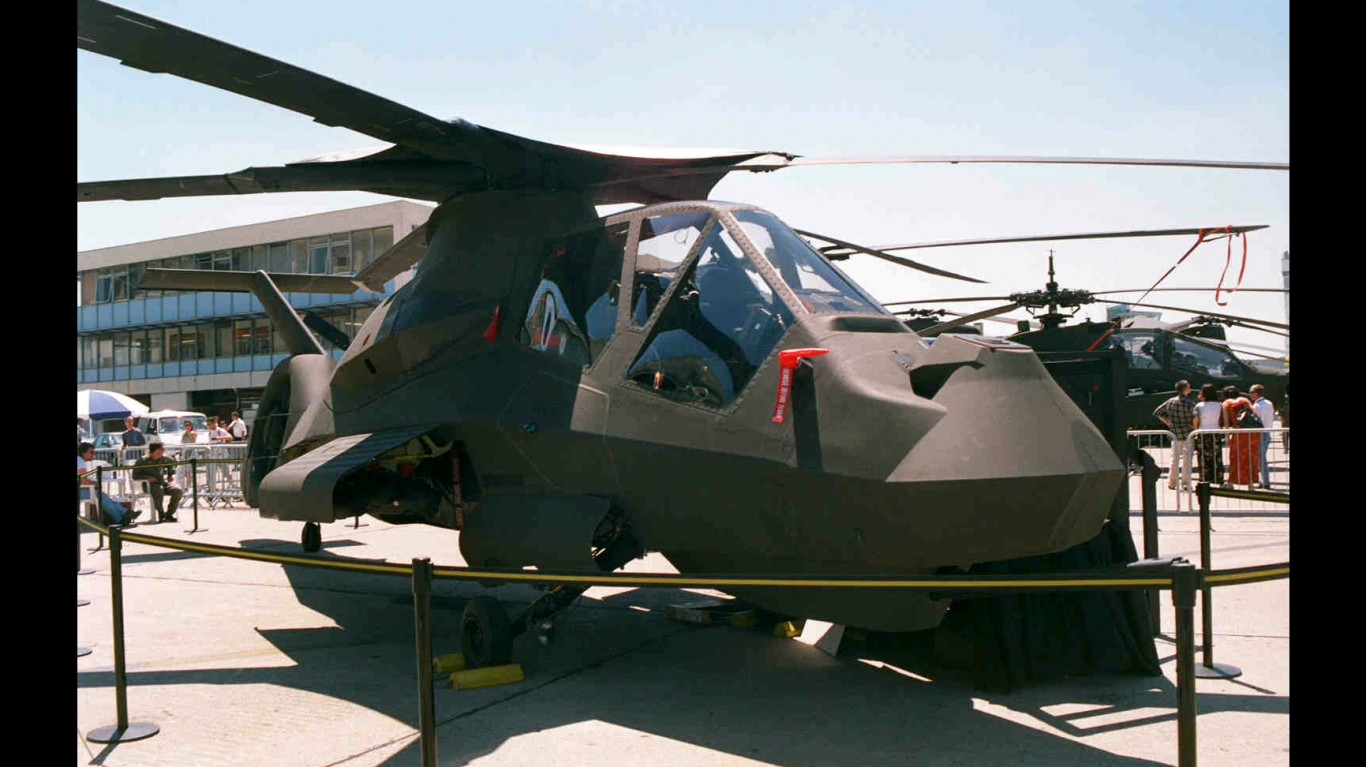
Boeing-Sikorsky RAH-66 Comanche
> Time period: 1990s
> Type: Helicopter
> Project goal: Serve as armed reconnaissance air support
The Boeing-Sikorsky RAH-66 Comanche was originally designed to replace the Cayuse, Cobra, and Kiowa helicopters as the fast and versatile helicopter of the future. It would serve as an attack helicopter as well as being capable of running stealth reconnaissance missions, thanks in part to its sleek ultra-light build. Development of the aircraft was slow, due in part to budgeting disputes and technical issues; though the project was launched at the height of the Cold War, and the first prototype didn’t appear until 1996.
Unfortunately, it turned out that the RAH-66 wasn’t ultra-light after all. When it was fully loaded, it was so heavy that there were concerns that it might not even get off the ground. In addition, the futuristic tech on the helicopter proved to be temperamental and ridden with glitches. Ultimately, the U.S. government decided the project would be too costly to perfect and that it made more financial sense to upgrade existing helicopters. The project, which cost about $7 billion, was canceled in 2004.

“Gay bomb”
> Time period: 1990s
> Type: Psychochemical weapon
> Project goal: Induce homosexual attraction in enemy troops
Surely the most bizarre of the U.S. military’s many canceled projects, the so-called “gay bomb” – officially called “Harassing, Annoying and ‘Bad Guy’ Identifying Chemicals,” was a project pursued by the U.S. Air Force in 1994. The idea was that spraying pheromones over enemy forces would supposedly affect their ability to fly planes or otherwise fight efficiently because they would suddenly become attracted to their fellow (male) soldiers. The scope of the project also included finding chemicals that would attract stinging bees and induce extreme body odors of various kinds (supposedly making it harder for the enemy to hide because their stink would give them away). , Thankfully this weird project never came to fruition, as information on it was leaked to the public and the $75 million funding request was denied.
[in-text-ad]
Expeditionary Fighting Vehicle
> Time period: 1990s-2000s
> Type: Amphibious assault vehicle
> Project goal: Replace the existing amphibious assault vehicle
Designed to replace the AA7A1 amphibious armored personnel carrier – designed in the 1970s and long overdue for an upgrade – the Expeditionary Fighting Vehicle (EFV) would have boasted three times the speed in water, twice the armor, and greater firepower. However, after an expenditure of $3.7 billion, the EFV was canceled in 2011 at the request of the U.S. Marines, just four years before its intended initial deployment. As with the Boeing-Sikorsky RAH-66 Comanche, it ended up making more sense to upgrade existing tech rather than invest in a new, expensive replacement.
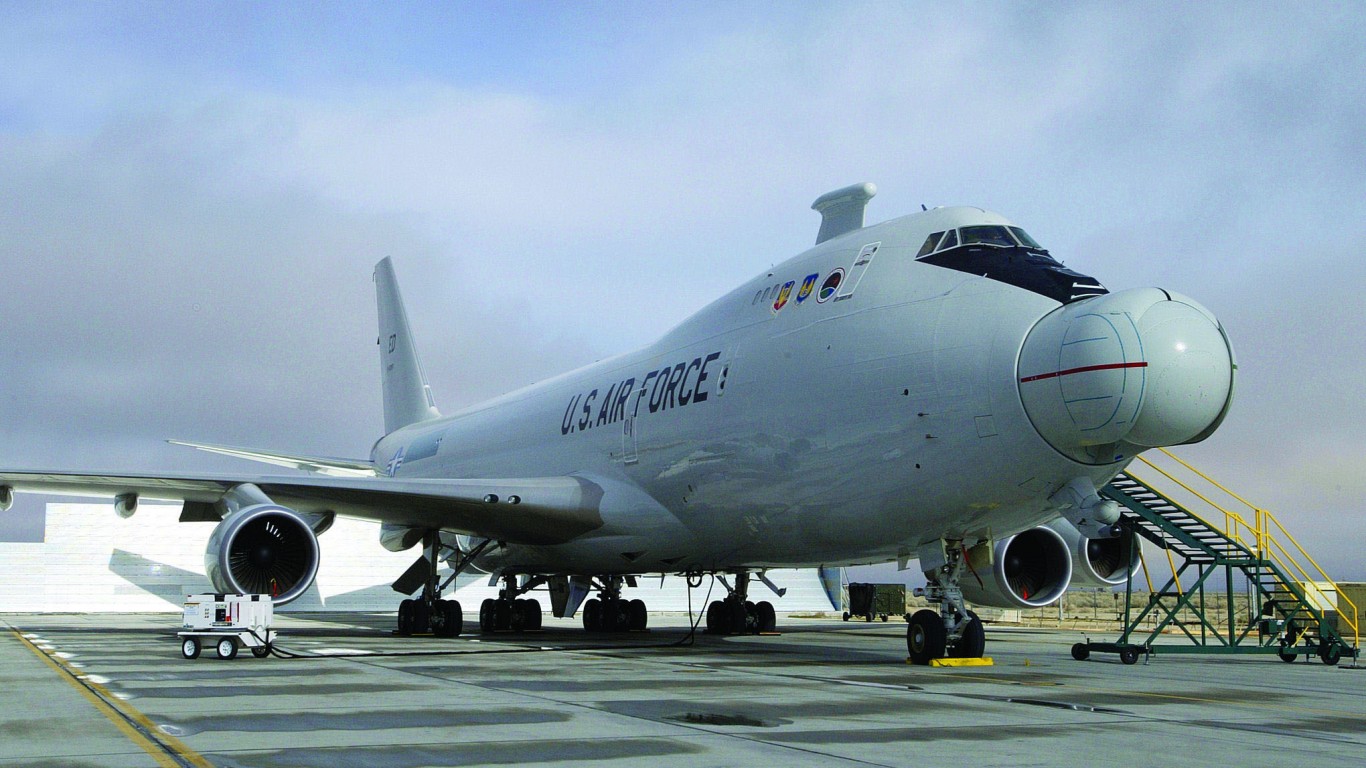
Airborne Laser
> Time period: 1996-2003
> Type: Laser mounted on aircraft
> Project goal: Destroy tactical ballistic missiles
The Airborne Laser – officially the Boeing YAL-1 Airborne Laser Testbed – was a military project straight out of a sci-fi movie. The goal of this project was to use a high-energy megawatt-class chemical oxygen iodine laser attached to a modified Boeing 747-400F to intercept incoming tactical ballistic missiles while they are still in their boost phase. Initial tests in 2010 proved promising with the YAL-1 being able to blast down two test missiles shortly after their launch. Unfortunately, it met the same fate as many of the other experimental aircrafts on this list: There were too many technical problems to justify its expensive operational costs. The project was canceled in December 2011 after racking up a cost of $5.2 billion.

National Polar-orbiting Operational Environmental Satellite System
> Time period: 2000s
> Type: Satellite system
> Project goal: Monitor Earth’s weather, atmosphere, oceans, and land
The National Polar-orbiting Operational Environmental Satellite System (NPOESS) was a project pursued jointly by the U.S. Department of Defence, NOAA, and NASA. The goal was to create a unified system that would record data on the climate, atmosphere, oceans, near-space environment, and the land itself. The data was to be used for more advanced weather forecasting and climate studies. The NPOESS was designed to replace existing NOAA and defense department satellites, using existing technology and more advanced sensors. Due to technical issues and cost overruns, the project was canceled by the White House in 2011, just two years before its intended release, after having cost $6.5 billion. Despite its cancellation, the legacy of the NPOESS lives on with the Joint Polar Satellite System (JPSS), launched in November 2017, a NOAA and NASA project built from the ashes of the NPOESS.
[in-text-ad-2]

Joint Tactical Radio System
> Time period: 2000s
> Type: Radio system
> Project goal: Replace existing military radio systems
The Joint Tactical Radio System (JTRS) was another attempt to unify military technology that ultimately ended up being a costly failure. The idea was to have a single software-based radio system that could be updated with new frequencies and modes as time went on rather than multiple systems for different tasks. Despite the relatively simple premise, the project proved to be complicated, due largely to internal restructuring. There were also cost overruns. Development lasted 15 years, cost $6 billion, and never delivered the promised product. The program was canceled in 2012.
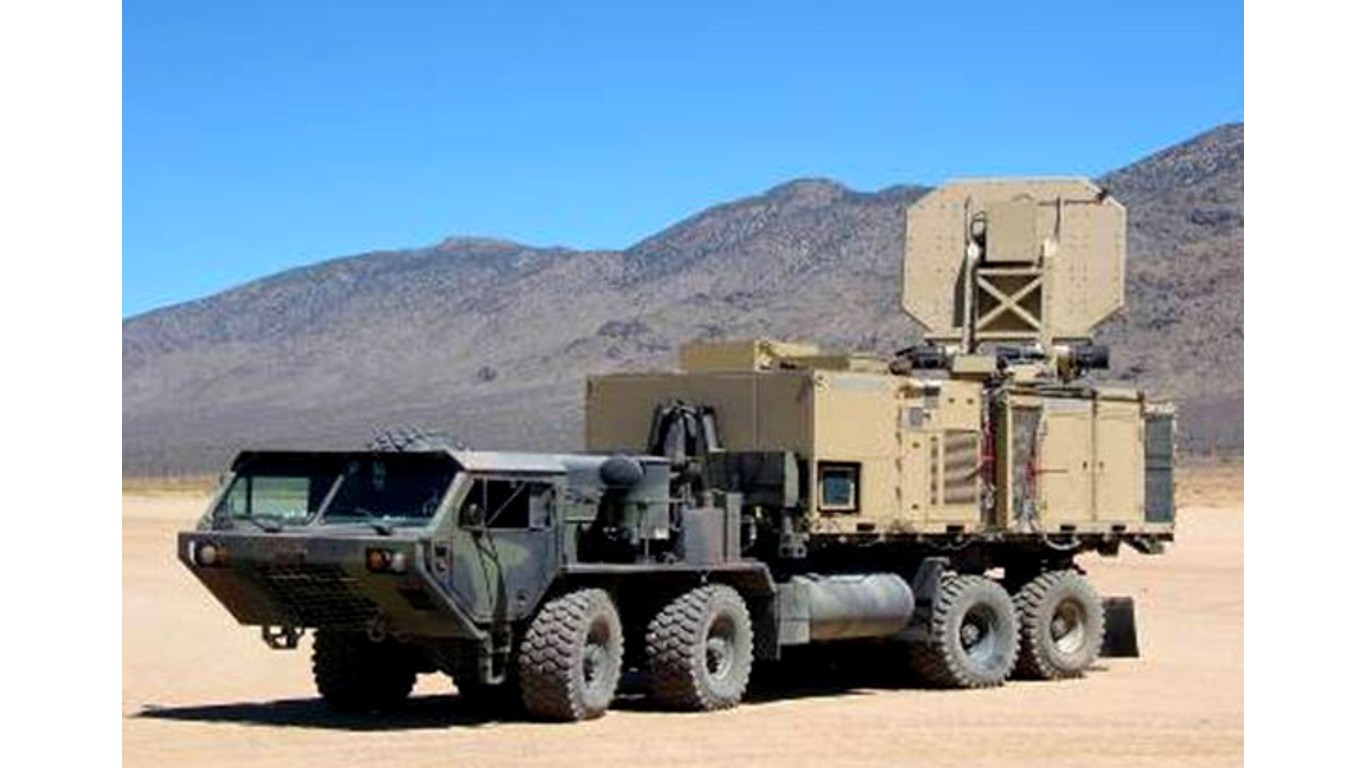
Active Denial System
> Time period: 2000s
> Type: Heat ray
> Project goal: Disperse people
The Active Denial System was a non-lethal crowd dispersal tool that shot a man-sized 95 GHz heat ray as far as 3,280 feet. Despite being “non-lethal,” an initial test burned a man who stood in the line of fire for only four seconds. Further tests produced inconsistent results. On one occasion, for instance, the pain the ADS was supposed to inflict was reduced to a pleasant warming sensation because it was raining. There have been multiple proposals for the use of the ADS both domestically and on the battlefield, but they have all been denied.
[in-text-ad]
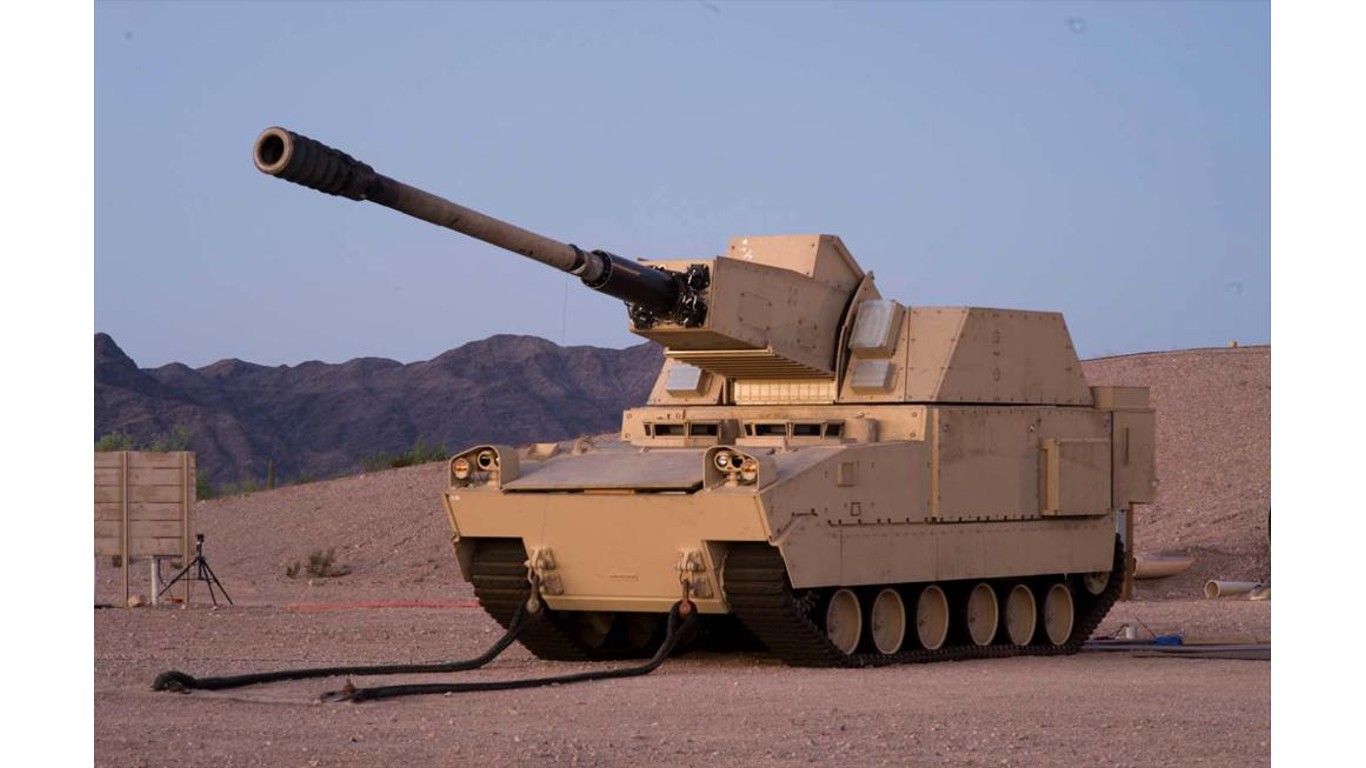
Future Combat System
> Time period: 2003-2009
> Type: Network of manned and unmanned vehicles
> Project goal: Create new brigades
The Future Combat System (FCS) was intended as a complete overhaul and modernization of the U.S. Army. The project would have introduced new brigades equipped with highly advanced manned and unmanned vehicles, including personnel carriers and a variety of tanks. The system would have been linked by an extremely fast and flexible wireless battlefield network, utilizing the (failed) Joint Tactical Radio System. This project might have been too ambitious, as the technology required was extremely expensive to develop, and our involvement in the Iraq war meant that the demands of battlefield technology were ever-changing. The FCS program ran for six years before being canceled with nothing to show for it.
A-12 Avenger (the Flying Dorito)
> Time period: Cold War
> Type: Stealth bomber
> Project goal: Replace the aging A-6 Intruder
Designed as a replacement for the A-6 Intruder, the A-12 Avenger was another weird experimental aircraft project that was canceled. Nicknamed the “Flying Dorito” after its resemblance to the beloved cheesy corn chip, the A-12 Avenger was supposed to be a next-generation stealth bomber that could operate under any weather conditions while avoiding enemy radar. Like most other experimental aircrafts from the Cold War, the Flying Dorito was met with many expensive technical difficulties. The project was canceled in 1991.
Get Ready To Retire (Sponsored)
Start by taking a quick retirement quiz from SmartAsset that will match you with up to 3 financial advisors that serve your area and beyond in 5 minutes, or less.
Each advisor has been vetted by SmartAsset and is held to a fiduciary standard to act in your best interests.
Here’s how it works:
1. Answer SmartAsset advisor match quiz
2. Review your pre-screened matches at your leisure. Check out the advisors’ profiles.
3. Speak with advisors at no cost to you. Have an introductory call on the phone or introduction in person and choose whom to work with in the future
Thank you for reading! Have some feedback for us?
Contact the 24/7 Wall St. editorial team.
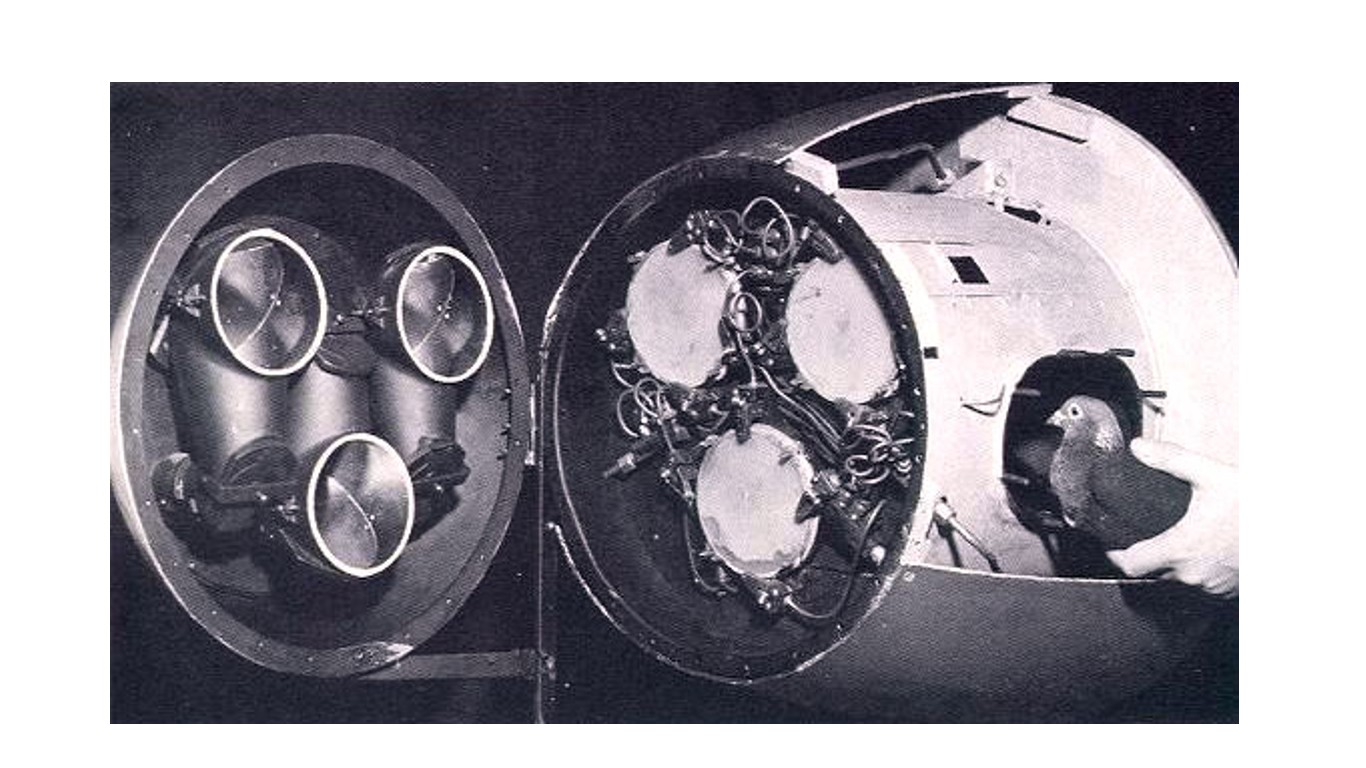
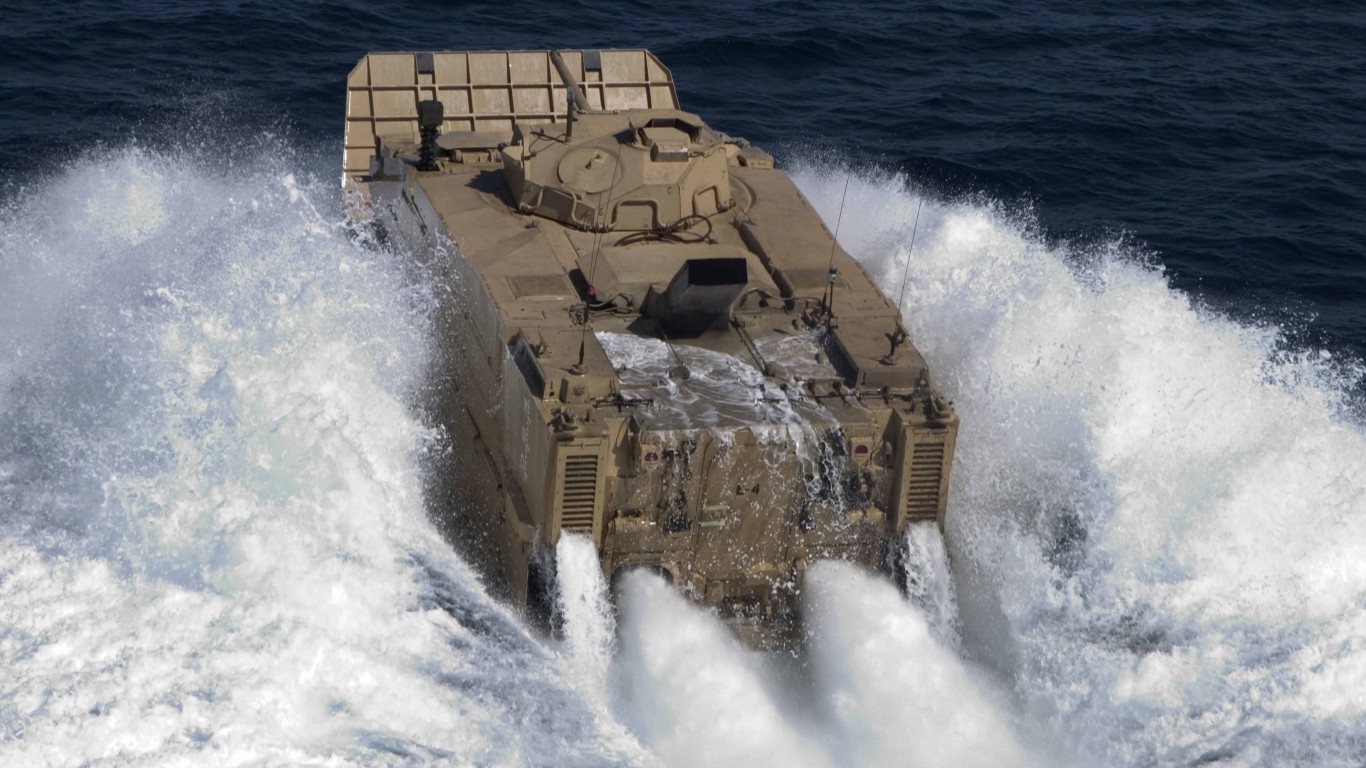 24/7 Wall St.
24/7 Wall St.
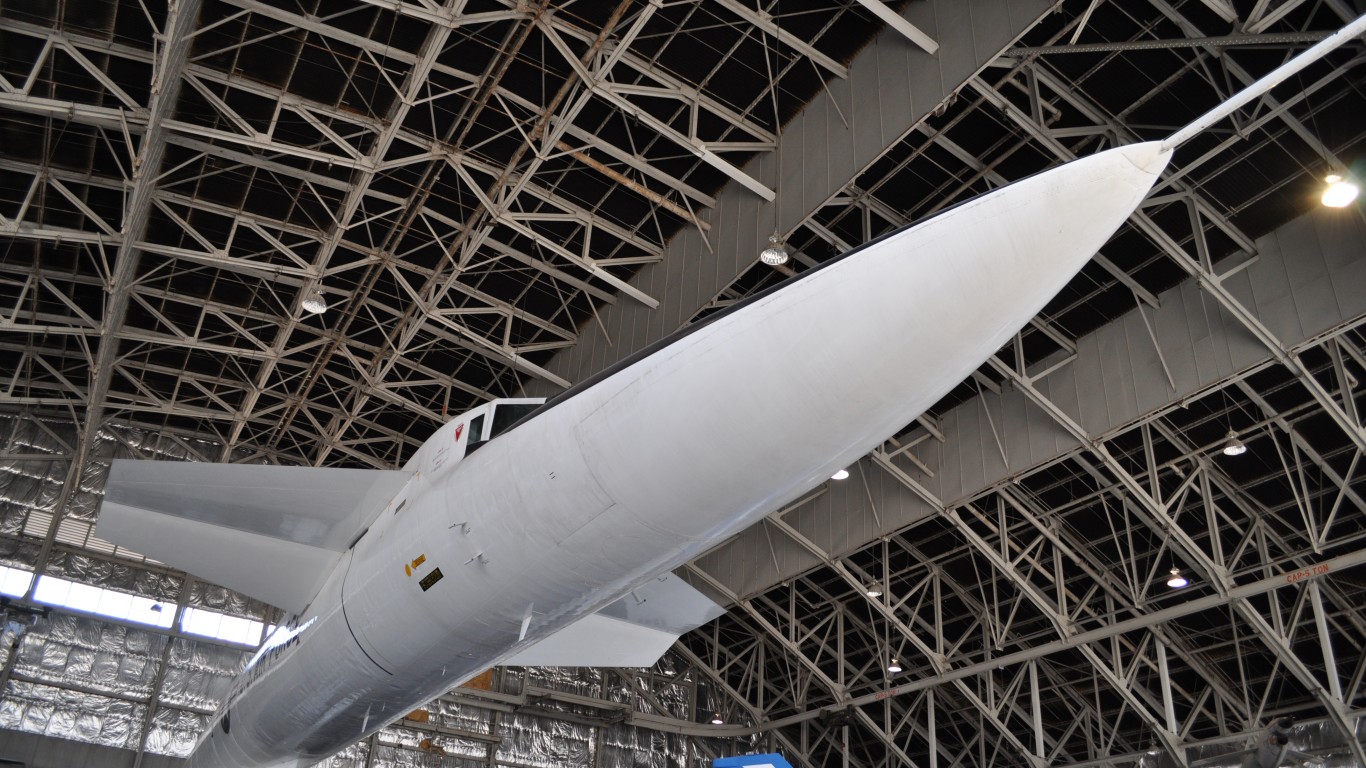

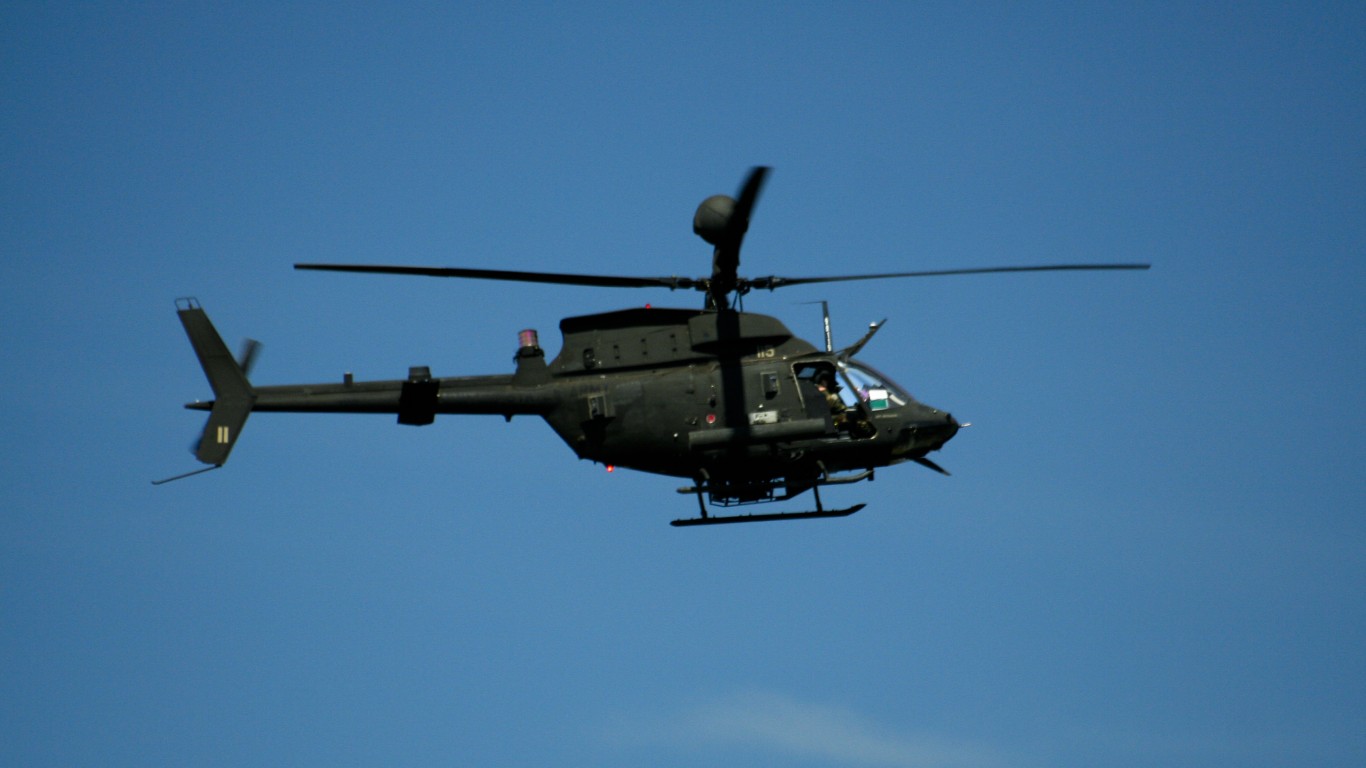 24/7 Wall St.
24/7 Wall St.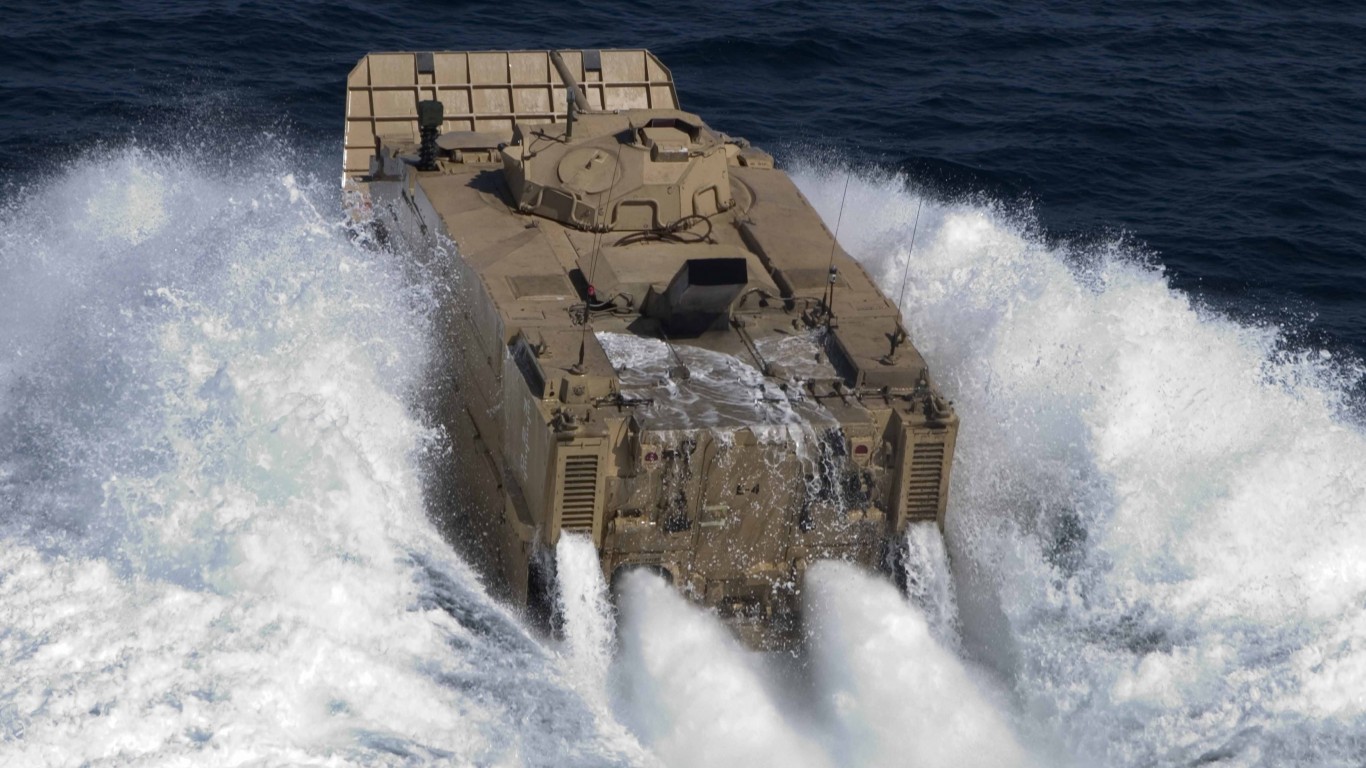
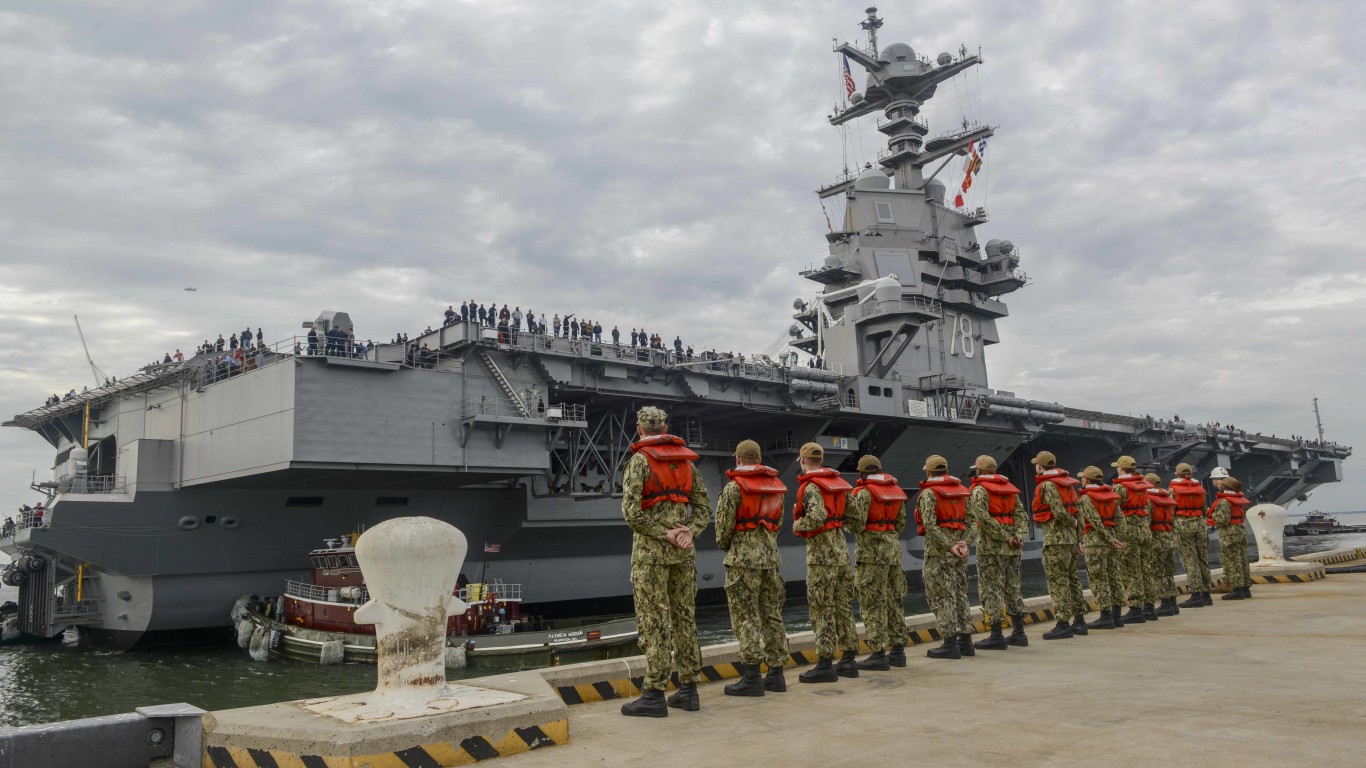 24/7 Wall St.
24/7 Wall St.